Last updated on July 4th, 2024 at 11:19 pm
Say goodbye to worries about chewed-up crib rails with our DIY no-sew fleece crib rail covers. Is your little one turning their baby crib into a teething ring? Those tiny teeth can leave their mark on both your baby’s crib and your peace of mind.
Good news, we have a great idea for you.
We’ve got a simple solution that’s as easy as it is effective. In just a few simple steps, you can protect both your baby’s precious teeth and their cozy sleep space at the same time.
No sewing machine? No problem. With this pattern, there is no sewing involved and no fancy tools. No fabric ties to sew on, no seam allowance, no quilt batting to worry about, and it’s machine washable. I use the delicate cycle when I wash ours.

What is a Crib Rail Cover?
A crib rail cover is a protective piece of fabric that is designed to wrap around the rails of a crib, providing a barrier between the wooden or metal rails and your baby’s teeth.
Babies often use crib rails as teething toys, gnawing on them to soothe their sore gums. A crib rail cover prevents damage to the crib caused by chewing and protects your baby’s delicate gums and emerging teeth from splinters or rough surfaces.
Continuous chewing and gnawing can cause wear and tear on the crib rails, potentially leading to splinters or damage to the finish. By covering the rails with fabric, you can extend the lifespan of your crib and maintain its appearance.
Crib rail covers come in various styles and materials, including fleece, fabric, or even waterproof plastic crib rail covers. They can be secured to the crib rails using ties, Velcro, or snaps, and are typically easy to install and remove for the washing machine.
Do you need a crib rail cover?
Every baby goes through teething. This phase can last for months, and they will chew on things to help bring relief. If your little one is starting to explore the world with their mouth and those crib rails are becoming their favorite teething toy, then a crib rail cover might just be the solution you need.
It worked for my grandson. He was chewing like a little beaver one day. Just a simple covering was enough to keep him from chewing there. We only needed to make one for each of the side rails. The end rails are still tall enough that he can’t reach the tops.
Not only does it protect your baby’s little teeth from unnecessary wear and tear, but it also safeguards the crib itself from damage. Plus, it can add a pop of color and personality to your nursery decor. If you’re tired of seeing teeth marks on your crib and worried about the safety of your baby’s gums, a crib rail cover could be just what you’re looking for.
No Sew Fleece DIY Crib Rail Cover
This is a simple pattern. I love that it is a no sew. The hardest part is taking the measurements and marking your fleece fabric for the cutting lines.
It’s a common problem and making your own crib rail cover is a low cost solution.
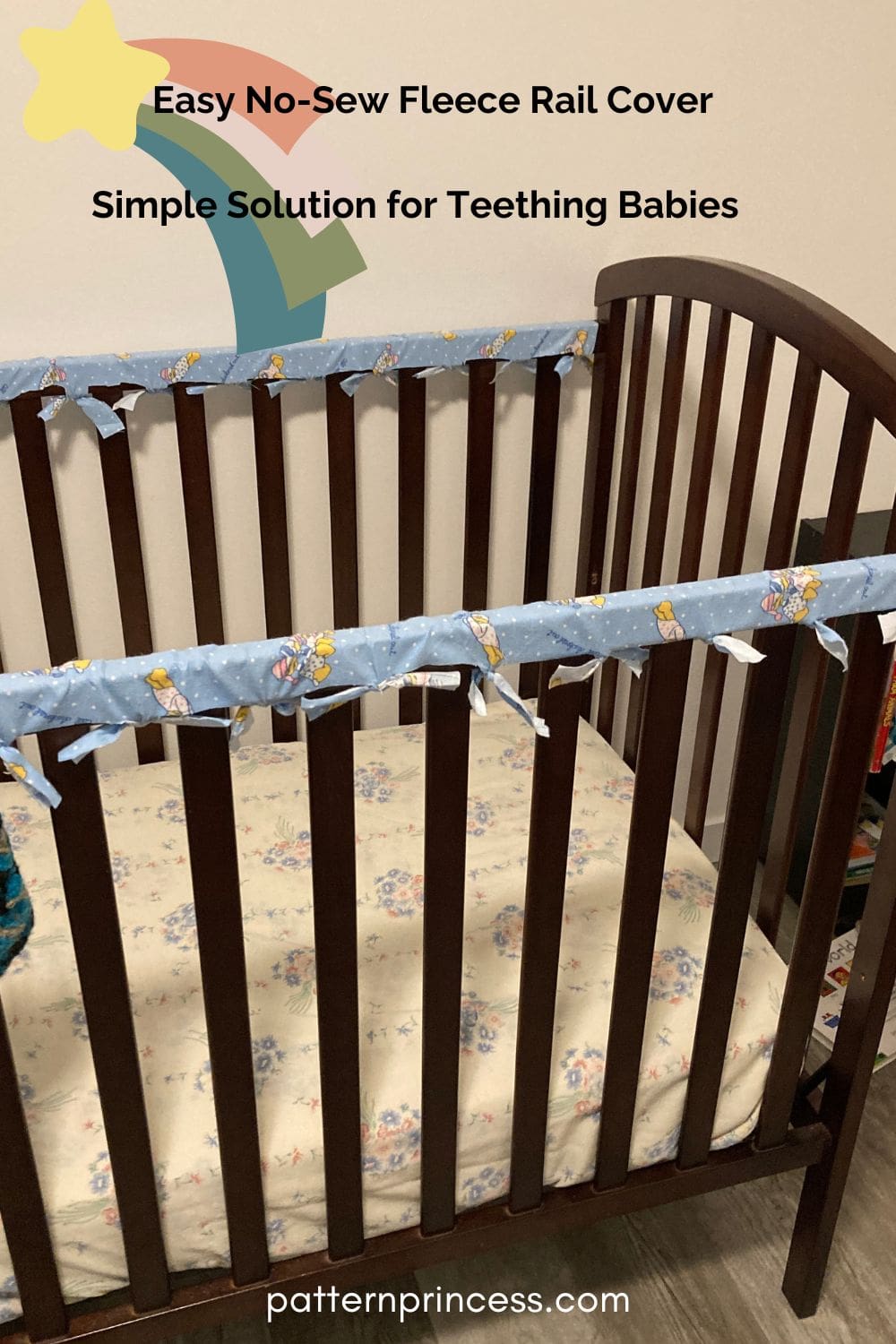
Directions: Easy DIY No-Sew Fleece Crib Rail Cover
Skill Level
Easy
Time
This whole thing including the measuring, marking, cutting, and tying took just over an hour to complete.
Supplies
Making a no-sew fleece crib rail cover is a straightforward project that requires just a few supplies. Here’s what you’ll need:
Fabric
Fleece Fabric. You will need two long pieces of fabric. Fleece is a great choice because it will not fray and there are so many fleece colors to choose from. You can use a brown fleece to blend in with the dark crib or use something colorful. I used what I had on hand. Making this perfect for a no sew option. Choose a soft, durable fleece fabric in a color or pattern that complements your nursery decor. The amount of fabric you need will depend on the overall length and height of your crib rails, so measure them beforehand to ensure you purchase enough material. Our size is 22 1/2 inches wide by 52 inches long. (2 pieces).
A yard of fleece fabric is 36 x 36 inches. Therefore, we needed 3 yards of fleece.
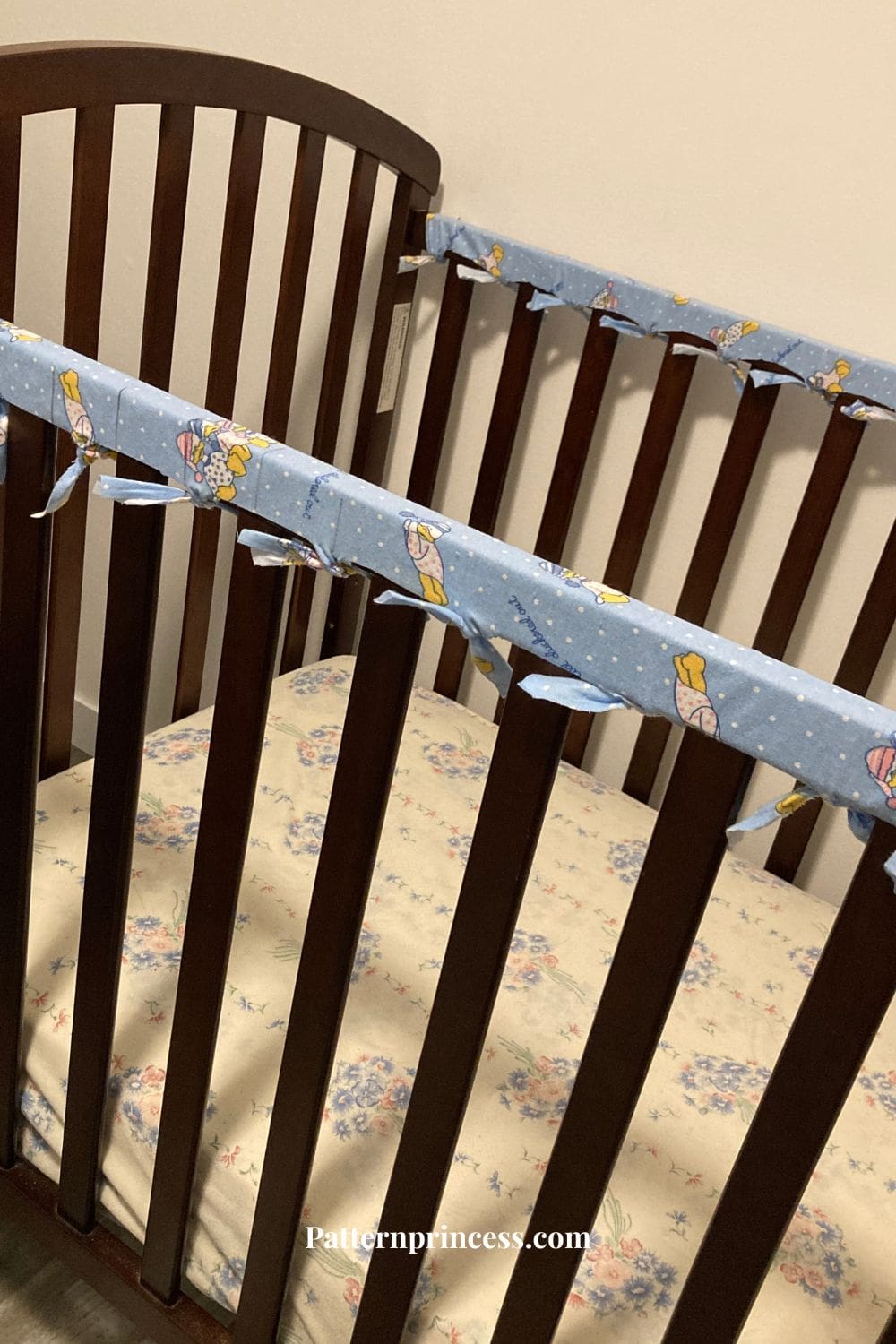
Materials
Scissors. You’ll need a pair of sharp scissors for cutting the fleece fabric to the correct size.
Measuring Tape. This will help you accurately measure the length and height of your crib rails, as well as the dimensions of the fabric you’ll need to cut.
Ruler. This is great for both measuring and tracing the cutting lines.
Marking Pen or Pencil. Use this to mark the cutting lines on the back side of the fabric.
With these basic supplies on hand, you’ll be ready to create a cozy and protective crib rail cover for your little one’s nursery.

Measurements
The first thing you need to do is take the measurements of your crib railing and the length between the slats. Make sure to take your own measurements as cribs can be slightly different sizes.
Our Crib Measurements:
Rail Length = 52”
Rail Height and Width = 3 ¾” Total
- 2 ¾” rail height
- 13/16” rail width
Between slats: measure center to center = 3 1/2”
Calculating the height and length of your strip of fleece.
Since your crib rail is 52 inches long, that is your length. Now, let’s calculate the height.
When calculating the height, you need to multiply your measurements by 2. This is because you need to have enough fabric to go over the crib rail and tie a knot between each slat.
When we add the rail height and width, we have approximately 3 ¾”. To make the calculations easier, let’s change this to decimals. 3.75 X 2 = 7.5. Plus, I need 3-5 inches to tie a knot. I chose 5 inches. 5 X 2 = 10. Therefore, the width needs to be 22.5 – 23 inches wide.
For us, our piece of fleece needs to be 22 1/2 inches wide by 52 inches long.
Note: We chose to have 1” wide strips X 5” long ties.
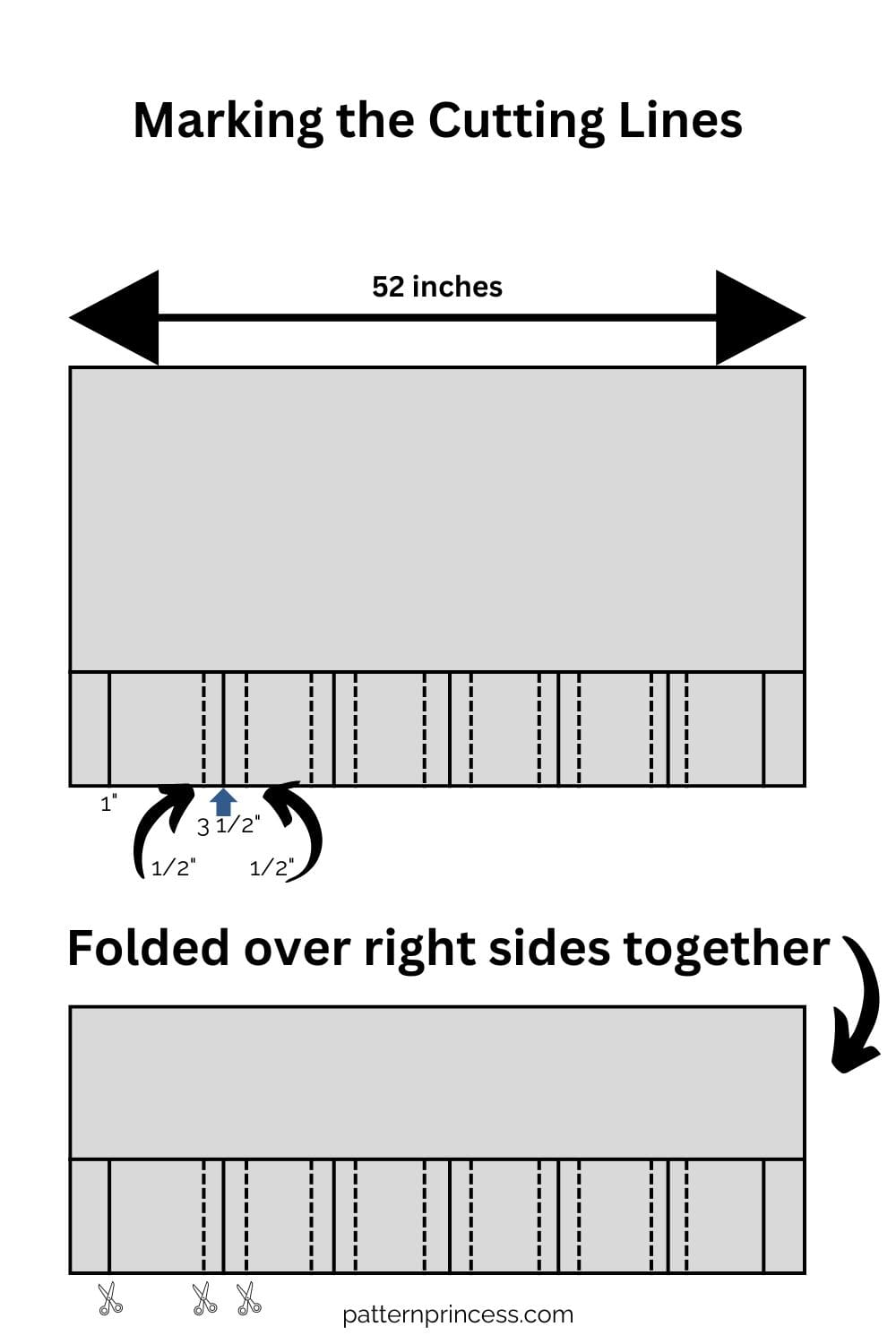
Marking the cutting lines on the fabric.
Working with one length of fabric at a time, lay the fleece right side down on a flat surface. The table or the floor for marking works nicely.
We are using 5 inches of fabric for ties. Therefore, we used our ruler to mark 5-inches in from the bottom edge on one side and drew a long line the length of the fabric. We don’t have to mark the other side. I have a time saving trick I’ll explain more below. (The space between where you just marked will be the part that goes over the crib rail).
Marking our Cutting Lines for the Slats
Since we did not make any special ties for the ends, the first tie will be in the middle of the first slat on either end.
Therefore, measure 1” in on either side and draw a line from the edge to the line you just drew at the 5” mark.
Our openings between the slats measured 3 ½”; however, we want 1” ties. Therefore, when measuring our cutting lines, we need to account for that.
Place your ruler on the 1” line you just drew for the ties on the end. Measure over 3 ½” and draw a line from the 5” mark to the edge of the fabric. Repeat this process across.
Next draw a line ½” away on either side of the lines you just drew in the previous step. (Cut cutting line will be at this 3” mark).
(The 3 ½” line is the center of the railing line, by marking the ½” on either side, this is marking off the ties).
Let’s save time!

Cutting the Fabric
Fold your fabric lengthwise with the right sides together. I ironed mine to things lined up nicely.
Cut through both layers of fabric at once. You will be using the lines you just marked as cutting lines. (Only cut up to the 5” line you drew lengthwise. Do not cut past that point).
Make your first cut at the 1” line on the end up to the 5” marked line.
Next cut the line at the 3” mark, making sure to stop at the 5” line. Refer to the diagram for help on exactly where to cut.
Now cut out the piece of fabric by cutting on the 5” line. You should now have a 1” strip of fabric on the left, and a square or rectangular space.
Continue cutting out the 1” strips along the length of the fleece. Skip the next line, which should be the 3 ½” mark. And cut along the next line. Then skip to the next line and cut. Finally, cut out the piece of fabric by cutting along the 5” line.
Continue cutting the fabric creating the 1” strips. End with cutting on the marked 1” line on the other end as that is for the other tie.
Repeat this entire process for the other crib rail cover.
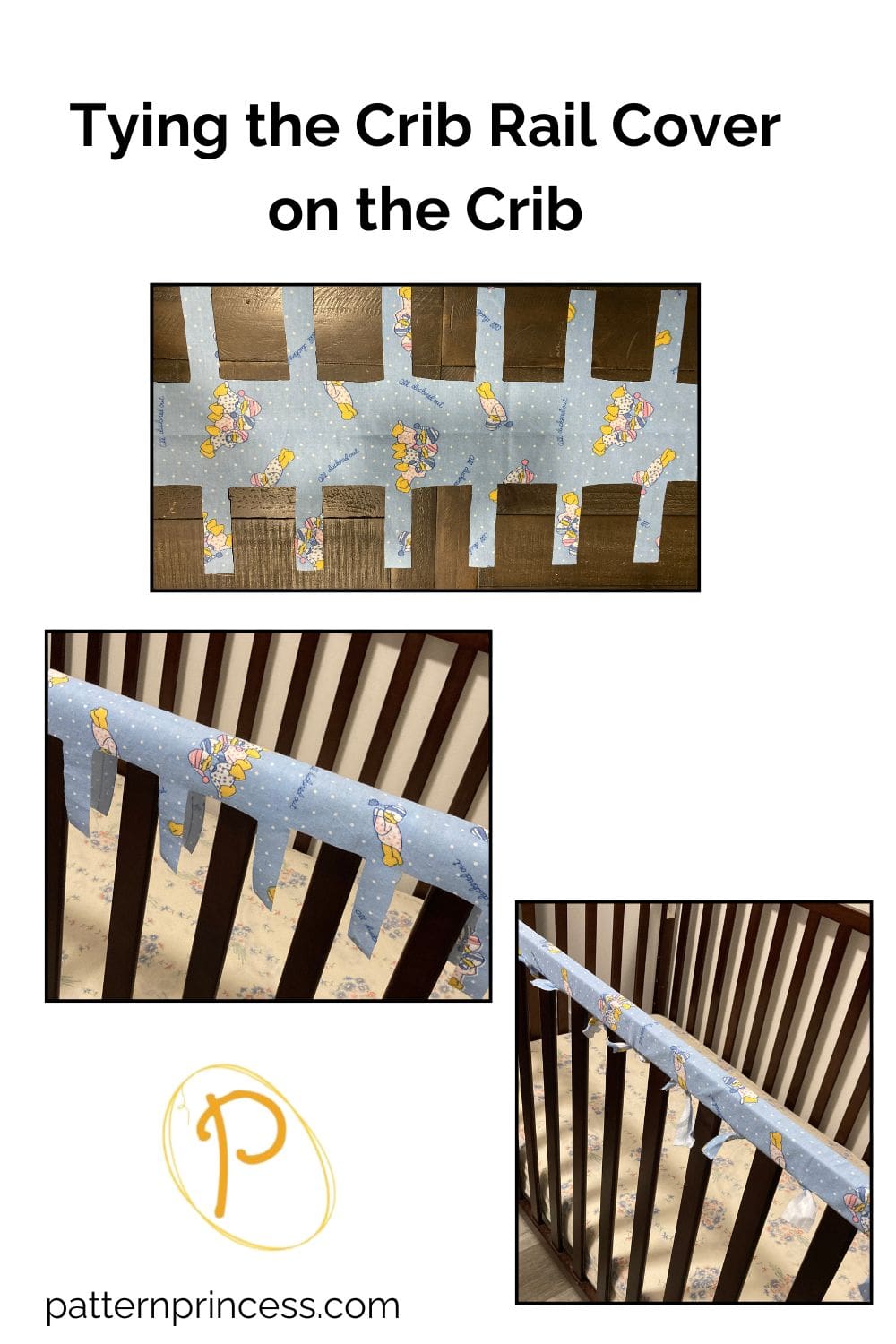
Tie the No-Sew Fleece Crib Rail Cover on the Crib
I enlisted my daughter’s help for this. Lay the strips on the railing of the crib and start tying the ends together between the slats. To tie them securely, we used a square knot.
Easy DIY No-Sew Fleece Crib Rail Cover
Equipment
- Scissors: You'll need a pair of sharp scissors for cutting the fleece fabric to the correct size.
- Measuring Tape. This will help you accurately measure the length and height of your crib rails, as well as the dimensions of the fabric you'll need to cut.
- Ruler. This is great for both measuring and tracing the cutting lines.
- Marking Pen or Pencil. Use this to mark the cutting lines on the back side of the fabric.
Materials
- Fleece Fabric. The amount of fabric you need will depend on the overall length and height of your crib rails, so measure them beforehand to ensure you purchase enough material. Our size is 22 1/2 inches wide by 52 inches long. (2 pieces). A yard of fleece fabric is 36 x 36 inches. Therefore we needed 3 yards of fleece.
Instructions
Measurements
- The first thing you need to do is take the measurements of your crib railing and the length between the slats. Make sure to take your own measurements as cribs can be slightly different sizes.
- Our Crib Measurements:

- Rail Length = 52”
- Rail Height and Width = 3 ¾” Total
- 2 ¾” rail height
- 13/16” rail width
- Between slats: measure center to center = 3 1/2”
- Calculating the height and length of your strip of fleece.
- Since your crib rail is 52 inches long, that is your length. Now, let’s calculate the height.
- When calculating the height, you need to multiply your measurements by 2. This is because you need to have enough fabric to go over the crib rail and tie a knot between each slat.
- When we add the rail height and width, we have approximately 3 ¾”. To make the calculations easier, let’s change this to decimals. 3.75 X 2 = 7.5. Plus, I need 3-5 inches to tie a knot. I chose 5 inches. 5 X 2 = 10. Therefore, the width needs to be 22.5 – 23 inches wide.
- For us, our piece of fleece needs to be 22 1/2 inches wide by 52 inches long.

- Note: We chose to have 1” wide strips X 5” long ties.
Marking the cutting lines on the fabric.
- Working with one length of fabric at a time, lay the fleece right side down on a flat surface. The table or the floor for marking works nicely.Fleece Fabric.
- We are using 5 inches of fabric for ties. Therefore, we used our ruler to mark 5-inches in from the bottom edge on one side and drew a long line the length of the fabric. We don’t have to mark the other side. I have a time saving trick I’ll explain more below. (The space between where you just marked will be the part that goes over the crib rail).
Marking our Cutting Lines for the Slats
- Since we did not make any special ties for the ends, the first tie will be in the middle of the first slat on either end.
- Therefore, measure 1” in on either side and draw a line from the edge to the line you just drew at the 5” mark.
- Our openings between the slats measured 3 ½”; however, we want 1” ties. Therefore, when measuring our cutting lines, we need to account for that.
- Place your ruler on the 1” line you just drew for the ties on the end. Measure over 3 ½” and draw a line from the 5” mark to the edge of the fabric. Repeat this process across.

- Next draw a line ½” away on either side of the lines you just drew in the previous step. (Cut cutting line will be at this 3” mark).
- (The 3 ½” line is the center of the railing line, by marking the ½” on either side, this is marking off the ties).
Cutting the Fabric
- Fold your fabric lengthwise with the right sides together. I ironed mine to things lined up nicely.
- Cut through both layers of fabric at once. You will be using the lines you just marked as cutting lines. (Only cut up to the 5” line you drew lengthwise. Do not cut past that point).
- Make your first cut at the 1” line on the end up to the 5” marked line.
- Next cut the line at the 3” mark, making sure to stop at the 5” line. Refer to the diagram for help on exactly where to cut.
- Now cut out the piece of fabric by cutting on the 5” line. You should now have a 1” strip of fabric on the left, and a square or rectangular space.
- Continue cutting out the 1” strips along the length of the fleece. Skip the next line, which should be the 3 ½” mark. And cut along the next line. Then skip to the next line and cut. Finally, cut out the piece of fabric by cutting along the 5” line.
- Continue cutting the fabric creating the 1” strips. End with cutting on the marked 1” line on the other end as that is for the other tie.
- Repeat this entire process for the other crib rail cover.
Tie the No-Sew Fleece Crib Rail Cover on the Crib
- I enlisted my daughter’s help for this. Lay the strips on the railing of the crib and start tying the ends together between the slats. To tie them securely, we used a square knot.

That’s it, you’re done and there was no sewing involved. For us, this easy diy crib rail cover took care of the teething baby chewing on the crib railing.

You can find Victoria crocheting, quilting, and creating recipes. She has cooked in restaurants for over 20 years, including many larger parties. She learned to crochet when she was just 11 years old and has been crocheting ever since; over 50 years now. Over 40 years ago, she loved her first class in sewing and continues to hone her skills in quilting. Many have enjoyed the handmade gifts over the years. In her professional career, she has worked in management in a wide variety of businesses including higher education as a dean of a division. All the while attending college part-time to achieve her doctorate in higher education with an emphasis in e-learning.


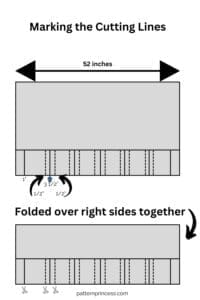

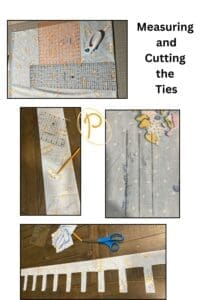

This was an easy way to protect our crib railing. Thanks for the easy instructions.
love this simple no sew railing cover.